|
History of Mt. Pulaski Courthouse
topic of March meeting of the Logan County Genealogical & Historical
Society
[March 19, 2025]
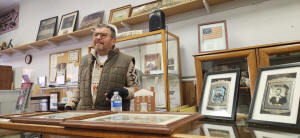
At the March Logan County Genealogical and Historical
Society meeting, Steve Martin shared information about the history
of the Mt. Pulaski Courthouse and the town of Mt. Pulaski.
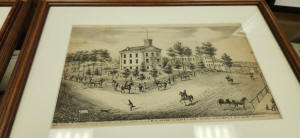
Martin serves as an interpreter at the Mt. Pulaski
Courthouse, which one of the few surviving buildings where Abraham
Lincoln practiced law. Martin said it is a point of pride for Mt.
Pulaski that Lincoln walked on those floors and sat at some of the
desks.
The original furniture from the courthouse is in Springfield. Former
Mt. Pulaski resident and radio star Vonda Leith had given the
courthouse a post office box that had belonged to Abraham Lincoln.
Martin said unfortunately, the box disappeared at some point.

From 1847-1855, Lincoln sharpened communication
skills, earned income to help support his family and built
relationships that would serve him well during his rise to power.
One of Lincoln’s friends was Jabez Capps, who helped found Mt.
Pulaski. Capps had a store down the street from Lincoln’s law office
in Springfield. Capps owned the block the old state Capitol was on.
Martin said Capps traded that block for a cookstove he brought up to
Mt. Pulaski.
When Lincoln visited Mt. Pulaski, he would stay with the Lushbaugh
family. Martin said Lushbaugh’s daughter described Lincoln as being
10 feet tall with hands the size of pancakes. She said his hair was
always a mess and his tie undone.
As Lincoln strutted back and forth in front of the judge’s stand,
Martin said he must have been quite a sight. The courtroom was often
packed during those sessions because it was quite a show.
The cases Lincoln heard at Mt. Pulaski Courthouse were mainly patent
cases and land disputes.
Lincoln had one cradle patent case that went to the Supreme Court.
Martin said the cradle case was about a patent on a cradle with
perpetual motion. The man who created the cradle thought it would
rock forever, but even with perpetual motion, the cradle would
eventually wind down. Lincoln joked the perpetual motion was like a
lot of politicians he knew. They start off great and then wind down.

The cradle patent case was actually about the
decoration on the cradle. Martin said the Supreme Court finally
decided against the man who wanted his money back. The judges told
the plaintiff he should have read the fine print.
One of Lincoln’s cases was a tombstone case. The tombstones were
supposed to be made of cast iron. Martin said research he and Marla
Blair have done show the tombstones were made of zinc. He said these
tombstones are so well preserved that they look new.
During this time, Judge David Davis presided over all the cases. In
a book Martin has been reading, there is a story that Judge Davis
and Lincoln were going over to Decatur to make the county courthouse
by the next day. The Sangamon River was swollen and the two men had
to swim across the most shallow place. Martin said they took their
coats off and pulled their horses across.
Judge Davis made sure speeches, debates and information about
Lincoln made it into East Coast newspapers. Martin said that helped
Lincoln win the election.
Lincoln did not even attend the Republican National Convention at
Wigwam Convention Center in Chicago in 1860. Martin said Davis ran
the whole show. When Judge Davis was running for Supreme Court
Justice, Lincoln was not sure whether he was going to appoint him.
Both Mary Todd Lincoln and a friend of Lincoln reminded him without
Judge Davis, he would not have become president.
When the Mt. Pulaski Courthouse was built, Martin said a Mt. Pulaski
resident raised $2700 to build it. The cost to complete the
courthouse was $3000. The other $300 came from Logan County when
they sold the Postville courthouse property.
The first trial held at the courthouse was over the $300 contributed
for the courthouse completion. Martin said the people who donated
the land for Postville wanted it back.
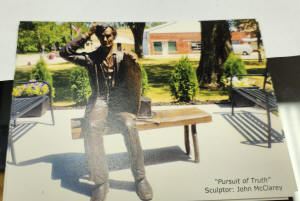
Martin said Lincoln would meet his clients in the
courtyard. One artist who made a statue of Lincoln depicted him
scratching his forehead. Martin said when he met with clients, he
was trying to decide whether to take their case.
[to top of second column] |

By 1855, the city of Lincoln was becoming more
populous due to the railroad. Martin said there was a vote to move
the base of the county government to Lincoln.
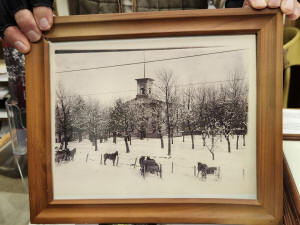
After the county government moved to a new courthouse
in Lincoln in 1855, Martin said the Mt. Pulaski Courthouse served
[at various times] as a schoolhouse, a post office and the town
library. Changes to the building included moving the first floor to
ground level and making the windows taller.
In 1935, the building that originally housed Mt.
Pulaski Courthouse was deeded to the State of Illinois and added to
the state historic sites with connections to Abraham Lincoln.
At that time, Martin said extensive remodeling was done to restore
the courthouse to its original condition. Lushbaugh’s daughter, who
was in her 90s by then, helped with the placement of the furniture.
The restored building has one original desk the prosecution and
defense would sit at Pews from a nearby church that closed around
1930 but are from the 1850s.

Most of the other furniture was not originally in the
courthouse, but Martin said it was from the 1850s.
Jim Hickey, who was from Elkhart, helped convince the state to save
Mt. Pulaski Courthouse as a historical site. Martin said Hickey was
very knowledgeable about Abraham Lincoln.
Martin said people from all over the country visit the courthouse.
Some see the signs showing the courthouse as part of the Looking for
Lincoln Trail. Many come to see the Lincoln statue but do not come
inside the courthouse.
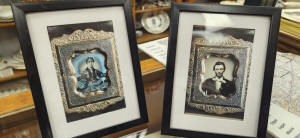
Memorabilia at Mt. Pulaski Courthouse includes a
photo of Lincoln in his late 30s or early 40s and did not have a
beard. Another is a photo of Fanny Henning, who Abraham Lincoln was
once sweet on. Martin said Lincoln was trying to decide between
Henning and Mary Todd. Hennings ended up marrying Lincoln’s good
friend Joshua Speed.
Some notable events have occurred in Mt. Pulaski over the years. For
example, Martin said in 1910, the Wright Brothers were flying their
plane from Chicago to St. Louis in a race with the train.
The brothers had engine trouble over by Decatur and had to land the
plane in a field at the end of Washington Street in Mt. Pulaski.
Many people came to see the plane because they had never seen or
even heard of a plane.
An artist did a mural of the Wright Brother’s plane on one building
in Mt. Pulaski. Martin said the plane ended up winning the race to
St. Louis.
The 1936 Mt. Pulaski basketball tournament is something Martin said
people still talk about.
Some may wonder why Mt. Pulaski has the nickname Vinegar Hill.
Martin said booze was transported in barrels labelled vinegar.
People would say they were going to Vinegar Hill.
Al Capone allegedly visited the town, but Martin said he has not
found any records with his name. He said Capone possibly used an
alias.

LCGHS President Bill Donath asked if a broken beam in
the courthouse attic had been taken care of.
Martin said the Mt. Pulaski Association raised money to repair the
beam. They replaced it with a wooden beam. He thinks it may have
cracked when there was an explosion of three tank cars (1958)
nearby. Many of the windows in town blew out during the explosion
and some churches had cracked beams.
Years ago, Martin said they used to have dances and dinners to raise
money for the Mt. Pulaski Association.
One person asked what the population of Mt. Pulaski was in 1847.
Martin said the town’s population was 800 to 1000 people when the
courthouse was built. He encouraged everyone to come visit the Mt.
Pulaski courthouse for a guided tour.
[Angela Reiners]
 |